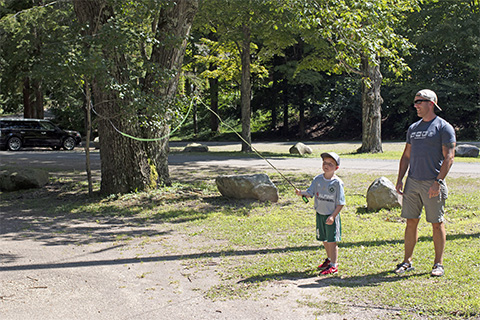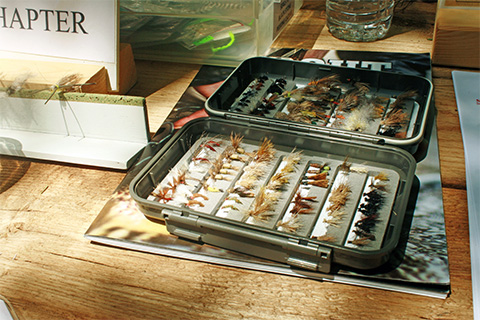Fly fishing is an angling method that uses a light-weight lure -- called an artificial fly -- to catch fish. The fly is cast using a fly rod, reel, and specialized weighted line.
The light weight requires casting techniques significantly different from other forms of casting as it is actually the weight of the line that propels the fly forward.
It takes practice to master, but not as much as many would-be fly anglers might assume.
Success in fly fishing results from accurate casts with a properly presented a fly. Flies should imitate whatever the fish are feeding on as closely as possible. This concept is called “matching the hatch” and flies can be tied to imitate any prey item found both above and below the surface of the water.
Many anglers are drawn to the artistic form of casting a dry fly and seeing the visual take from a fish as it grabs the fly from the water’s surface, but there is much more available in the world of fly fishing.
Flies also can be tied to represent the aquatic stages of many insects, as well as crayfish, minnows, leeches, and even mice; and each requires a different way of working the fly line.
Fly fishing represents a great opportunity for anglers to learn about aquatic life forms and their life cycles.
A beginning angler will quickly discover the kinds of insects on the waters they fish and when they typically hatch each year.
At first, the difference between mayflies, stoneflies, and caddisflies may seem a little daunting, but learning about them leads to success on the water.
Getting Started with Fly Fishing

Getting started in fly fishing has never been easier. There are many tutorial videos and articles online.
The Pennsylvania Fish and Boat Commission’s website provides a wealth of information for a budding angler.
For those who wish to tie their own flies, some fly shops and sporting goods stores offer hands-on courses for both beginners and those with more advanced skills.
For early success, it is best to start on a lake or pond with easier-to-target species such as bluegills and other panfish.
Lakes and ponds normally provide plenty of space for a new fly angler to cast; and bluegills and other panfish can be readily taken with a fly rod, which can boost a new angler’s confidence and help develop casting skills.

An angler can fly fish year-round in Pennsylvania, but the spring months of April through June are some of the best months because of the insect hatches on many rivers and streams that readily attract fish.
Spring also is a great time to target warmwater fish on the fly -- like bass and bluegills in lakes and ponds.
The summer months of July through September can be more challenging, but still productive.
Trout fishing is not as good at this time of year as in cooler-weather months, but it is a great time to pursue fish like smallmouth bass and carp.
The fall and winter months can be a good time for trout fishing, but anglers should be aware that brook and brown trout spawn in the fall and should be careful to avoid spawning areas.
Fly Fishing in State Parks and Forests

State forests and state parks offer abundant opportunities for fly anglers. Lakes and streams throughout many state parks and forests are regularly stocked with trout, and also feature great fly fishing for warmwater species such as bass, bluegills, and crappies.
Many of the headwater streams found in state forests have vibrant populations of wild brook trout which are the only trout species native to Pennsylvania.
They are our state fish and Pennsylvania has roughly 15,000 miles of streams that hold these wild wonders.
Fly fishing opportunities in state parks and forests are almost unlimited. Some of the best and most famous waters found on DCNR lands include:
- Penns Creek near Poe Valley and Poe Paddy state parks and in the Bald Eagle State Forest
- Youghiogheny River near Ohiopyle State Park
- Pine Creek in the Tiadaghton State Forest
- Kettle Creek near Ole Bull State Park
Economic Impact of Fly Fishing in Pennsylvania

The author holding a nice native brook trout caught in Tuscarora State Forest.
Because Pennsylvania is a water-rich state and home to some of the most fabled fly-fishing waters in the country, there is great opportunity.
There are 7.8 million fly anglers in the United States and the impact of fly fishing is estimated at $750 million in Pennsylvania.
Things to Know Before You Go

All anglers 16 years and older must have a valid Pennsylvania fishing license to fish Pennsylvania waterways.
Fishing licenses and boat registration fees (including launch permit fees required for canoes and kayaks) help protect and preserve Pennsylvania’s water resources and enhance the sport of fishing.
While fishing in state parks and state forests, all Pennsylvania Fish and Boat Commission regulations apply and all DCNR rules and regulations apply.
Some waterways have special regulations, so it is important to be familiar with the seasons, sizes, and creel limits before fishing at a location.
If you plan to fish for trout, you must possess a valid trout stamp permit. The Pennsylvania Summary of Fishing Regulations and Laws provides an overview of fishing regulations.
Many state parks open to fishing also have lodging available, including yurts, lodges, houses, modern cabins, and rustic cabins. Year-round or seasonal camping also is available at 60 parks. Reservations can be made online.
Some state parks have fishing piers to accommodate people with disabilities. Check with individual parks for specific ADA access information.
Additional Fly Fishing Resources

If you want to give it a try to see if fly fishing is for you, check the DCNR’s calendar of events for fly fishing programs.
The Pennsylvania Fish and Boat Commission also offers a variety of fly fishing programs, including programs just for women.